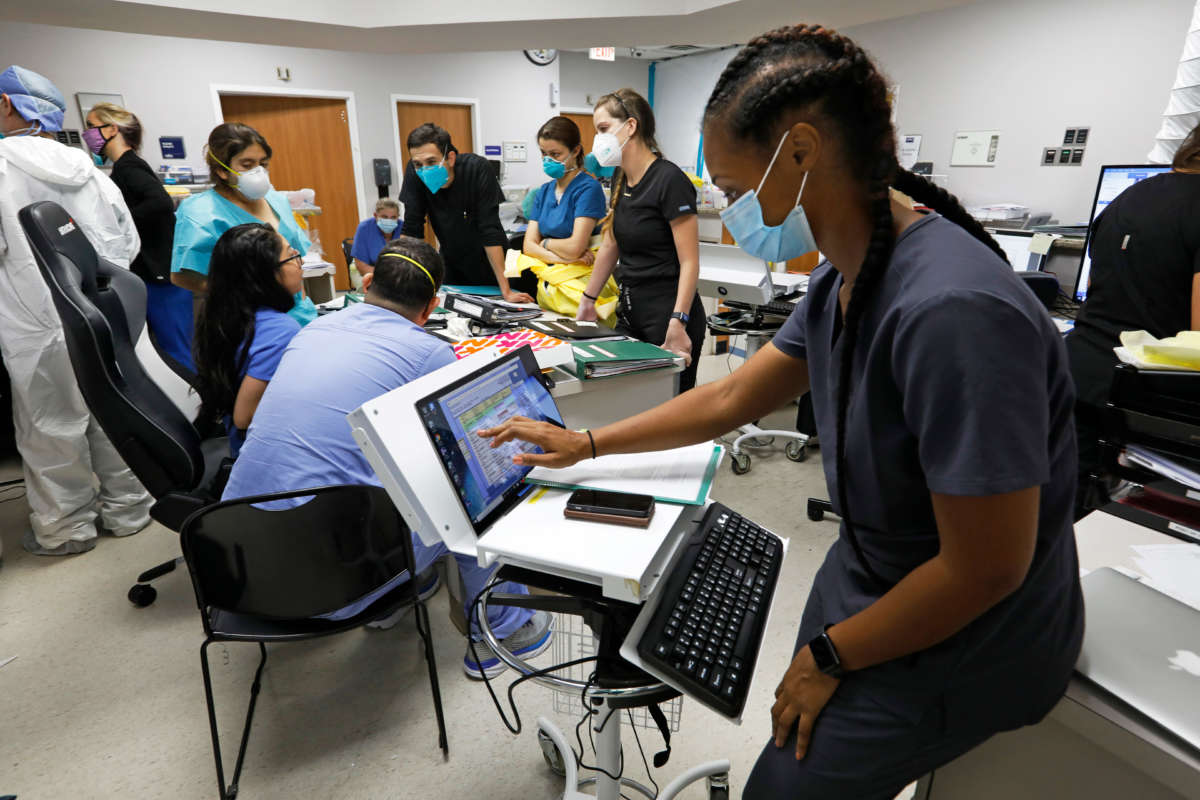Support justice-driven, accurate and transparent news — make a quick donation to Truthout today!
There’s been a lot of talk from Democrats in power about the bravery and sacrifice of health care workers and the importance of racial equity.
Words are nice, but they don’t improve people’s lives.
But there’s one simple policy, tantalizingly close to passing that can make things better for health care workers in an instant: canceling student debt.
Health care workers have more student loan debt than workers in any other industry, holding approximately $9,700 more in debt per person than those who work in higher education, who are the second-highest debt holders on the list. Private health care workers and social workers hold an average of $72,800 in student debt, which is more than double the national average. It’s worth noting that more than half of health care workers employed in direct-contact, home and community-based service positions are people of color. Average debt for nurses ranges from $19,928 for an associate’s degree to $47,321 for a master’s degree. Average debt from medical school is a staggering $215,900.
The entire health care industry is stitched to higher education and thus to student debt. So instead of offering a free coffee or a yard sign thanking health care workers, how about we cancel all student debt and dramatically improve their lives, and millions of others, immediately.
Though he would likely face challenges, President Biden could undertake this action via an executive order. And it’s not just a higher education problem; it’s also, as Congresswoman Ayanna Pressley stated, “ a racial justice issue.”
Black college graduates are more likely to receive federal loans and hold an average of $25,000 more in student loan debt than white borrowers.
Forty percent of Black grad school graduates hold student loan debt compared to 22 percent of white students, and over 50 percent of Black borrowers reported that their student loan debt is higher than their net worth. This is a textbook example of systemic, structural racism, which is something that the Biden administration has repeatedly pledged to address.
Before President Biden assumed office, 325 organizations — including many prominent labor unions, civil rights organizations and advocacy groups — sent a letter to the president-elect urging him to cancel all student debt with an executive order on day one. Obviously, that didn’t happen, but as the pandemic and all of its associated trauma has continued to spin on, the pressure for action has grown.
On February 4, Senate Majority Leader Chuck Schumer (D-New York), Sen. Elizabeth Warren (D-Massachusetts), Congresswoman Ayanna Pressley (Massachusetts-07), and others put forth a resolution calling for the president to cancel $50,000 in student debt for all borrowers.
Now is the time. Total student loan debt has now reached $1.7 trillion. Only nine countries have a GDP that surpasses that total. In the United States, student loan debt is growing at six times the rate of the economy. Canceling all student debt would make an enormous impact, clearing the debt of 43.2 million borrowers. By contrast, Schumer and company’s $50,000 forgiveness plan — which has a $125,000 income threshold for qualification — would eliminate debt for 36 million borrowers. It’s certainly better than nothing, and a significant improvement over the $10,000 Biden floated during the campaign. But what better time to be bold than right now? Why go three-fourths of the way?
Over 200,000 health care workers have been infected with COVID-19 over the past year, and at least 3,500 have died. They have dealt with insufficient personal protective equipment, overcrowding, underfunding, and an ever-present air of chaos, uncertainty and death. A survey on the well-being of health care workers conducted by Mental Health America found that 93 percent reported experiencing stress, 86 percent reported anxiety and 76 percent reported exhaustion. Many experienced insomnia and an array of physical ailments, in addition to being burdened with the constant fear of potentially exposing a family member. And, as with many aspects of U.S. society, the health care workers most impacted by infection, hospitalization and death — due in large part to the aforementioned prevalence in direct contact and home health positions — are disproportionately people of color. In fact, health care workers of color are nearly twice as likely to contract COVID-19 than white workers.
It has been an extraordinarily tough year to work in health care — and it’s an industry all but defined by tough years. Though there is a faint light flickering at the end of the tunnel due to widespread vaccinations occurring across the country, we have not defeated this pandemic just yet — and there is a mental health crisis looming just beyond it.
Health care workers aren’t going to get a break. They never get a break. A small respite between crises perhaps, some snapshots of catharsis, but never a real break.
While canceling student debt is certainly not a long-term fix (as it doesn’t address the pervasive problems with our higher education system), it would provide some instant relief for people who could really use it right now.
Press freedom is under attack
As Trump cracks down on political speech, independent media is increasingly necessary.
Truthout produces reporting you won’t see in the mainstream: journalism from the frontlines of global conflict, interviews with grassroots movement leaders, high-quality legal analysis and more.
Our work is possible thanks to reader support. Help Truthout catalyze change and social justice — make a tax-deductible monthly or one-time donation today.
